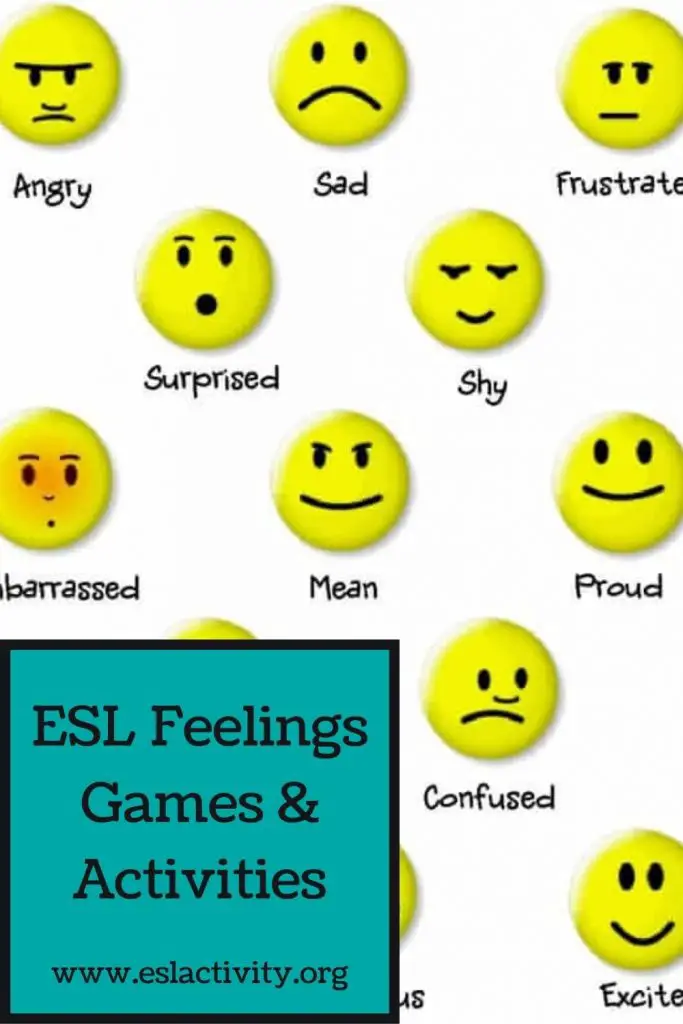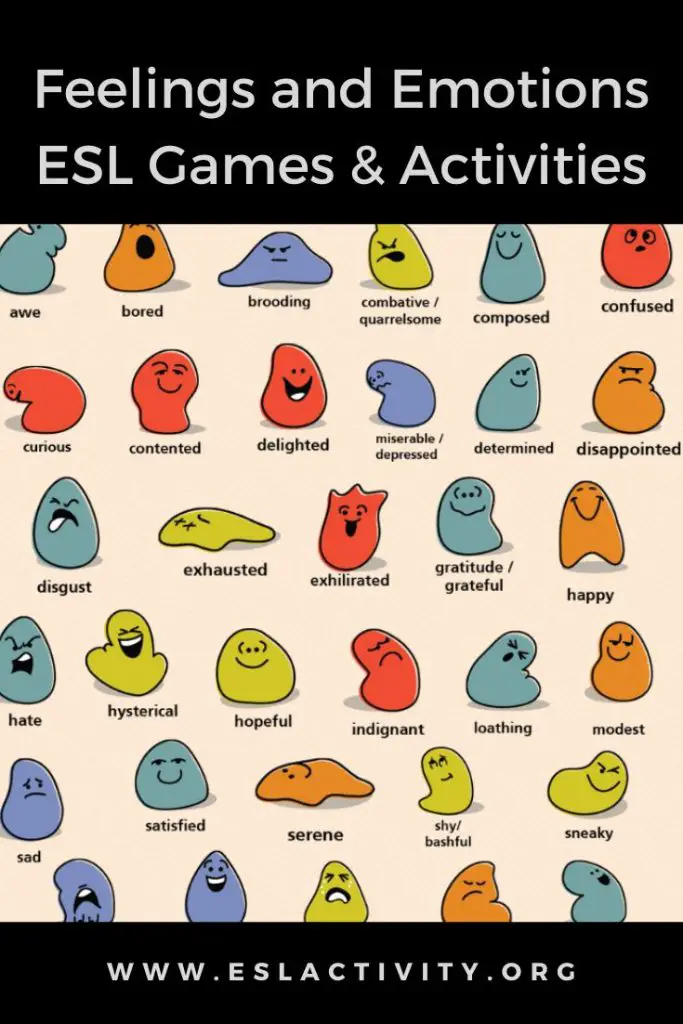If you’re looking for some of the best ESL feelings and emotions activities, then you’re in the right place. We have more than 20 of them, along with feeling worksheets, lesson plans, resources and more. Keep on reading.

Feelings ESL
Feelings and Emotions ESL Activities
Here are the best ESL feeling and emotion ideas for TEFL classes.
#1: ESL Emotions Word Association Activity
Unless students are absolute beginners, it’s likely that they already know a good number of emotion and feeling words. As a nice warm-up, it can be helpful to do a mind-map. Organize the words into happy, sad, mad words.
It’s a nice activity because it can help students activate their prior knowledge about a topic, which makes new words they might learn more memorable because they can associate them with words they already know. Check it out:
TEFL Word Association Activity.
#2: Dicto Gloss
This is a nice listening activity for higher-level students. Prepare a passage of someone talking about how they’re feeling. Sprinkle in a number of the key emotion or feeling vocabulary words. You might even find something suitable in the textbook you’re using in class.
Then, put students into pairs. Read the passage out at a faster than normal pace for the level of the students. They can take notes and try to replicate what they heard with their partner. Repeat the process and in the end, students can compare their version with the original one. Find out all the details here:
#3: Hot Potato
#4: Freeze Group Writing Activity
Try out this simple writing activity with your students. Prepare some different starters on each sheet of paper. For example:
- Tom was feeling sad because . . .
- Jenny was feeling so angry because . . .
Then, each student has to add a sentence or two and then pass it on to the next student. In the end, read out the stories to the class. Find out more:
#5: Emotion and Feelings Flashcards
I rarely come to any class with kids without some flashcards in my teacher’s basket! They are super versatile and can be used for a million and one games and activities.
When teaching kids about feelings or emotions, a set of related flashcards can be so useful. They mean that I don’t always have to make the relevant emotion with my face which can be quite tiring! Find out all the things you can do with them here:
ESL Flashcard Activities and Games.
#6: Me Too!
This is a simple speaking and listening activity for beginners. Students have to make a sentence using a feeling or emotion. For example:
- I feel happy when I eat pizza.
- I feel sad when my brother takes my toys.
Go around the class and each student has to say their statement. If anyone else in the class agrees, they can stand up and say, “Me too!” Learn more about it:
#7: A to Z Alphabet Game for Emotions
#8: Spelling Challenge
This is a nice activity for beginners who are just learning new emotion or feeling vocabulary words. It’s basically a race at the whiteboard to spell the word correctly first. Whoever does, gets a point for their team. Have a look here:
#9: Emotions and Feelings Role-Plays
I love to use role-plays in my classes with beginners because they allow them to kind of replicate real-life and gain some confidence with speaking. For feelings and emotions, I give students a starter like this.
A. Hey ____, how are you doing?
B. Oh, not great. I’m feeling very _____.
A. Oh no! What happened?
B. . . .
Or, you could do the role-play for something positive. Just change the second and third lines. Learn more about using this activity in TEFL classes:
#10: Video Clips
A nice activity to try out is watching a clip from a movie or TV show that displays some strong emotions. Play it for your students and then have them discuss the emotions the people are feeling.
#11: Dictogloss
#12: ESL Surveys
Just ask my students and they’ll tell you that I love to use surveys in my classes! They’re so useful for a wide range of situations, including ESL feelings.
On your survey sheet, include questions like:
- What makes you feel angry?
- When do you feel bored?
- What was the happiest period of your life?
Find out all the details here:
#13: Dictation Practice for Emotions
I know that dictation is a bit of an old-school language learning activity but it still has some value and I like to use it once in a while. I make up some sentences that contain the target vocab words. In this case, feeling or emotion words. Then, I read out the sentences and students have to write them down in their notebooks. Check it out:

Feelings games for English Learners
#14: ESL Idiom Activity for Feelings
There are a ton of idioms related to feelings and emotions. Here are just a few of them:
- All the rage.
- Scare the living daylights out of someone.
- Get carried away with something.
- Mad as a hatter.
- At my wit’s end.
- Down in the dumps.
- Fly off the handle.
Here’s a nice activity to make these very memorable:
#15: Picture Prompt
#16: Man/Woman on the Street Interview Activity
This is a fun way to get students talking to each other in an interesting way! Get a pretend microphone and students have to talk to each other about emotions or feelings. They could start with something like:
- Tell me about a time you felt really happy.
- What makes you feel annoyed?
Then, depending on what the answer is, they could ask some follow-up questions. Learn more about this fun activity here:
Man/Woman on the Street Interview Activity.
#17: Odd One Out
Try out this very simple vocabulary activity with beginners students. Write down 4 words on the board and students have to say which one is the odd one out. For example:
- happy, sad, overjoyed, proud
Students might choose sad as the odd one out because it’s the only negative emotion of the group. Learn more about it here:
#18: Dialogue Substitution
#19: 3 Things Writing Challenge
This is a nice writing activity for intermediate or advanced students. Each student has to choose 3 things (one of them should be an emotion). Then, they have to tell their partner who has to write a short story about them. Check it out:
#20: A-Z Warmer Activity
If your students are at an intermediate or advanced level, they probably already know lots of feeling/emotion words. Help them activate this prior knowledge before jumping into your lesson plan with this simple warmer:
#21: Guess the Feelings Quiz for ESL
#22: Emotion Charades
Write different emotions on small cards and place them in a container. One student at a time selects a card and acts out the emotion without speaking, while the rest of the class tries to guess the emotion being portrayed. This activity helps students recognize and understand facial expressions and body language associated with different emotions.
#23: Feelings Vocabulary Cards
Create a set of flashcards with pictures or words depicting different feelings and emotions. Distribute the cards to the students and ask them to find a partner. Each pair takes turns showing a card to their partner and describing a situation that would make them feel that particular emotion. For example, if the card shows “happy,” they might say, “Winning a game makes me feel happy.”
#24: Emotion Drawings
Provide students with paper and art supplies. Assign different emotions to each student or have them choose one from a list. Students then draw a picture representing that emotion. Afterward, they can share their drawings with the class and explain why they chose specific elements to convey the emotion.
Expressing Emotion ESL Worksheets
Why reinvent the wheel, right? That’s where these ESL feelings worksheets can come in. Just print them off and them it to class. Yes, it really is that easy!
ESL Feelings Lesson Plans
Check out these ESL emotion and feeling lessons to try out with your students:

Feeling and emotions activities
ESL Emotions and Feelings Vocabulary
Here are some of the key ESL feelings vocabulary words to consider teaching your students:
- afraid
- angry
- anxious
- confident
- confused
- curious
- depressed
- devastated
- disgust
- envious
- excited
- exhausted
- happy
- heartbroken
- hopeful
- humble
- hurt
- lonely
- miserable
- modest
- nervous
- outrage
- overjoyed
- proud
- rage
- sad
- scared
- shocked
- suspicious
- terrified
- thoughtful
- withdrawn
- worried
Did you like these ESL Feelings Activities?
- Amazon Kindle Edition
- Smith, Jennifer Booker (Author)
- English (Publication Language)
- 134 Pages - 03/31/2016 (Publication Date)
Yes? Then you’re going to love this book that you can easily find on Amazon: 101 ESL Activities for Kids. The key to better English classes with children is a wide variety of interesting games and activities and this book will help you get there in style.
You can find it in a variety of formats. Pick up your copy today and get ready for better English classes tomorrow:
ESL Emotions FAQs
There are a number of common questions that people have about teaching ESL feelings and emotions. Here are the answers to some of the most popular ones.
Why is teaching feelings and emotions important for English learners?
Teaching feelings and emotions is crucial for English learners as it helps them develop their language skills and improve their communication abilities. Understanding and expressing emotions accurately allows learners to engage in meaningful conversations, build stronger relationships, and navigate social interactions effectively.
How can teachers effectively teach feelings and emotions to English learners?
Teachers can use various strategies to teach feelings and emotions to English learners, such as incorporating visual aids, role-playing activities, and real-life scenarios. They can also introduce relevant vocabulary, idiomatic expressions, and gestures associated with different emotions. Encouraging open discussions and providing a supportive learning environment will further enhance learners’ understanding and expression of emotions.
What are some engaging activities for teaching feelings and emotions to English learners?
- Emotion Charades: Students act out different emotions while others guess the emotion being portrayed.
- Feelings Vocabulary Gallery: Create a classroom display featuring pictures or drawings representing various emotions, and encourage students to describe and discuss them.
- Emotion Diary: Have students maintain a diary where they can write about their daily experiences and the emotions they felt. They can share and discuss their entries with classmates.
- Role-Play Scenarios: Assign students different roles in imaginary situations that evoke specific emotions. They can act out the scenarios and engage in dialogue related to the emotions portrayed.
- Emotion Word Bank: Collaboratively create a word bank with emotion-related vocabulary. Students can use this resource for writing exercises, discussions, or storytelling.
How can teachers promote empathy and understanding of others’ emotions among English learners?
Teachers can foster empathy and understanding by incorporating activities that encourage students to consider others’ perspectives and emotions. Some strategies include engaging in group discussions about empathy, reading literature with diverse characters and emotional experiences, and using real-life scenarios to analyze how different individuals might feel in certain situations. Teachers can also model empathy through their own actions and provide opportunities for students to practice active listening and providing emotional support to their peers.
How can teachers assess the progress of English learners in understanding and expressing emotions?
Teachers can use a variety of assessment methods, such as:
- Written Assignments: Students can write essays, reflections, or journal entries describing their emotions and experiences.
- Oral Presentations: Assign students to give presentations about specific emotions, their causes, and how they can be managed or expressed.
- Role-Play Assessments: Students can participate in role-plays where they demonstrate their understanding of emotions through dialogue and actions.
- Observational Assessments: Teachers can observe students during class discussions, group activities, or presentations to assess their ability to express and understand emotions accurately.
ESL Feelings and Emotions: Join the Conversation
Do you have any go-to ESL emotion or feeling games or activities that you like to use with your students? Leave a comment below and let us know your thoughts about it. We’d love to hear from you.
Last update on 2022-07-17 / Affiliate links / Images from Amazon Product Advertising API






